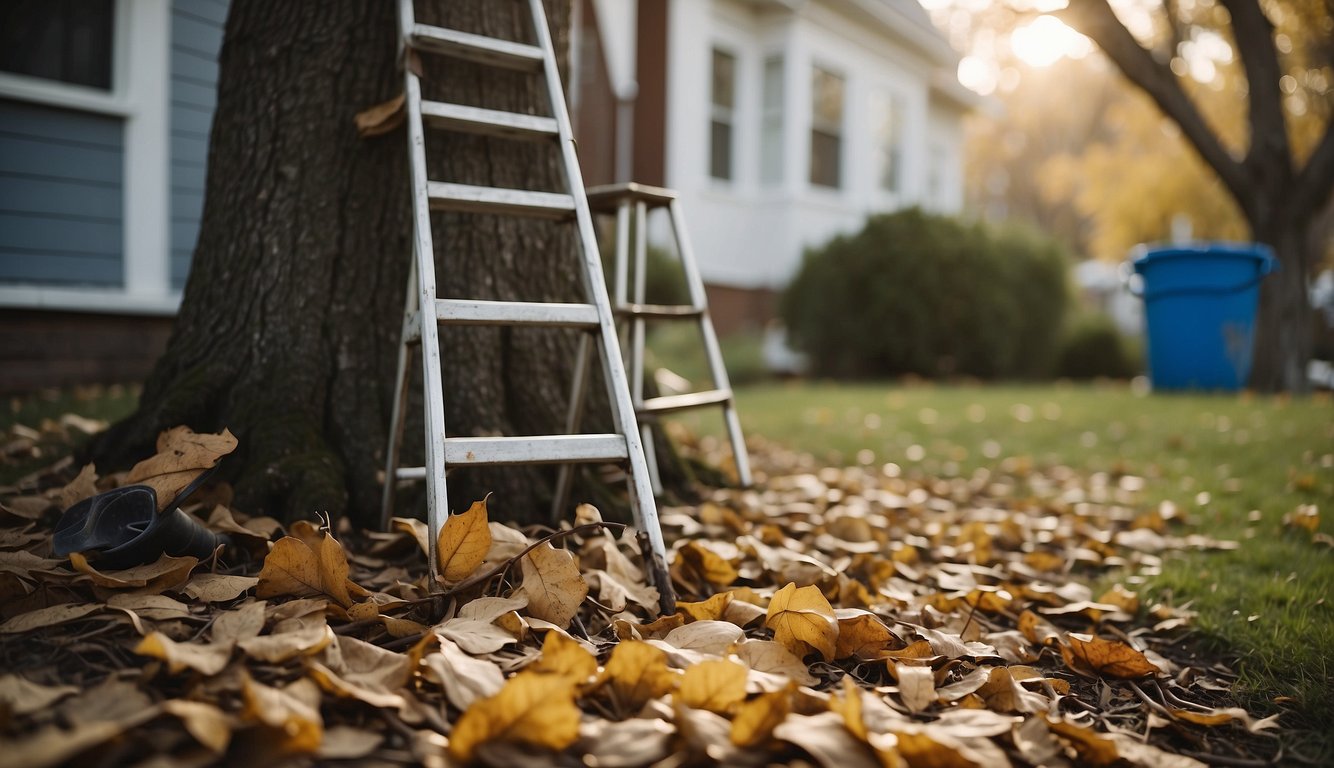What Month Should You Clean Gutters: Optimal Timing for Maintenance
Maintaining gutters is a critical task for any homeowner, ensuring that water is properly diverted away from the home to protect its structural integrity. It’s generally best to clean gutters at least twice a year, in the spring and fall. Cleaning in the spring addresses debris that has accumulated over the winter, while a fall cleaning clears away leaves and twigs that can lead to blockages during rainstorms.

Depending on the surrounding environment, such as the presence of overhanging trees and the local climate, the frequency of gutter cleaning may need to increase. Homes surrounded by trees may require gutter cleaning up to four times a year to prevent clogs and potential damage. We advise monitoring your gutters regularly and after heavy storms to determine if additional cleanings are necessary.
Determining the Best Time to Clean Gutters

To maintain a home’s integrity and prevent water damage, it’s critical to clean gutters at strategic times throughout the year. We’ll look at seasonal and geographical factors, as well as tree types that necessitate more frequent cleaning.
Seasonal Gutter Cleaning Guidelines
- Early Fall: Prime time for gutter maintenance to ensure they’re ready for increased rainfall.
- Spring Cleaning: Essential to clear winter debris and prepare for spring showers.
Table: Gutter Cleaning Frequency by Season
| Season | Suggested Cleaning Action |
|---|---|
| Early Fall | Clear leaves, sticks, debris |
| Late Fall | Final post-leaf drop clean |
| Spring | Remove winter debris |
| Early Summer | Post-shedding season check |
Clean gutters after leaves have fallen and before heavy rain or snow. This equates to at least twice a year: once in late spring or early summer after seeds and blossoms have fallen, and once in early fall.
Geographical Considerations
- Rainy Areas: Frequent cleaning, potentially quarterly, to handle constant debris.
- Dry, Windy Regions: Less frequent, but intense storms dictate at least biannual checks.
Your geographic location influences how often you should clean your gutters. For example, regions with consistent precipitation may require more frequent attention to prevent clogs and damage.
Influences of Tree Types Nearby
- Pine Trees: Shed needles year-round, requiring quarterly gutter cleaning.
- Oak Trees: Massive leaf shed in fall, necessitating thorough early fall cleaning.
Different trees shed at various times and rates. Pine trees can drop a lot of needles, which means homeowners with pine trees nearby might find themselves cleaning gutters up to four times per year. If your property hosts oak or other deciduous trees, you’ll want to schedule a thorough cleaning in early fall once most leaves have dropped.
Preparing for Gutter Cleaning

Before we climb the ladder to clear our gutters, it’s critical to be well-prepared with the right safety measures and tools. This will ensure the job is done efficiently and safely.
Safety Measures
Eye Protection: Always wear safety goggles to protect our eyes from debris.
Sturdy Ladder: Use a reliable ladder that’s in good condition and appropriate for our house’s height.
Gloves: Work gloves are essential to protect our hands from sharp objects and dirt.
Tools and Equipment
Ladder: Essential for reaching the gutters.
Gloves: Heavy-duty gloves to protect hands during cleaning.
Safety Goggles: Protect eyes from potential debris.
Gutter Scoop: Helps in removing gunk and debris effectively.
Bucket: For collecting debris; attach it to the ladder for convenience.
Garden Hose: Useful for flushing out the gutters after scooping out the debris.
Pressure Washer (optional): Can be used for a more thorough cleaning, if handled carefully.
Leaf Blower (optional): A handy tool for blowing out loose debris.
| Tool/Equipment | Description |
|---|---|
| Ladder | A stable, reliable ladder is critical. |
| Work Gloves | Heavy-duty gloves to guard against cuts. |
| Safety Goggles | Necessary for protecting our eyes. |
| Gutter Scoop | Handy for scooping out leaves and muck. |
| Bucket | Collect the debris to keep our work area clean. |
| Garden Hose | For a final rinse to ensure clear gutters. |
| Pressure Washer | Useful for stubborn areas, but use with caution. |
| Leaf Blower | Can quickly clear out dry debris from gutters. |
To begin, position our ladder on a stable, dry surface. Ensure we have all of our tools within reach to avoid unnecessary trips up and down the ladder. Let’s make sure to properly secure the bucket to our ladder so that we can safely collect the debris.
Step-by-Step Gutter Cleaning Process
Properly cleaning your gutters is critical to prevent water damage and maintain your home’s structure. Follow our clear and manageable steps to ensure your gutters are free from debris and fully operational.
Removing Debris
Firstly, safely position a ladder where you can comfortably reach your gutters. Wearing gloves, begin at the corners and work towards the middle, removing leaves, twigs, and any other debris that can cause clogged gutters. For efficiency, consider using a small plastic scoop to clear out the dirt.
- Materials Needed: Gloves, ladder, plastic scoop/trash bag.
- Work in sections to stay organized.
- Dispose of debris in a trash bag or bucket.
Flushing Gutters and Downspouts
After debris removal, it’s time to flush the gutters with a hose. This helps remove the smaller particles and checks for proper water flow. Ensure water runs clear from the downspout. If water trickles out or there’s a backup in flow, you may have a blockage, indicating downspout cleaning is necessary.
- Tools Used: Garden hose or pressure washer.
- Check for a clear water pathway.
- Address any water flow issues immediately.
Inspecting for Repairs
Finally, as the water flows, inspect your gutters for leaks. Look for cracks or sags that might need gutter sealant or other repairs. Additionally, survey for the presence of gutter guards or gutter screens that might need maintenance to inhibit future debris accumulation, mold growth, or rodents.
- Check gutter slope: Gutters should have a 1/4″ slope for every 10 feet to ensure proper drainage.
- Seal any small holes or cracks with gutter sealant.
- Consider installing gutter guards to minimize debris buildup.
Addressing Common Gutter Problems
When gutters are neglected, clogs, pest infestations, and water damage can occur. Each issue can lead to costly repairs if not addressed promptly.
Handling Clogs
Clogs are a primary concern in gutter maintenance. Leaves, twigs, and debris can block the flow of water, leading to water spilling over the sides of the gutters. Regular cleaning, especially after the fall season, can prevent these blockages. For prevention, installing gutter guards may reduce the amount of debris that enters the gutters.
- Immediate Actions to Take:
- Remove visible debris by hand or with a gutter scoop.
- Flush out gutters with a hose to clear any remaining particles.
Preventing Pest Infestations
Gutters can become breeding grounds for insects and a haven for rodents if not properly maintained. Stagnant water from clogged gutters allows insects to thrive. To prevent pests:
- Pest Infestation Prevention:
- Ensure gutters are free-flowing to prevent standing water.
- Check and seal any gaps where rodents could enter the gutter system.
Dealing With Water Damage
Water damage to the roof, fascia, and foundation can result from overflowing gutters. This type of damage can manifest as rot or mold on wooden components of the home or as cracks in the foundation. Preventative measures include:
- Preventative Measures for Water Damage:
- Inspect gutters regularly for signs of overflow.
- Confirm gutter downspouts direct water away from the foundation.
By paying close attention to these aspects of gutter maintenance, we can effectively prevent the most common gutter problems and protect our homes from potential damage and unnecessary repair costs.
Gutter Maintenance and Enhancement
Proper gutter maintenance prevents roof damage and protects your home’s foundation. We’ll guide you through regular upkeep and improvements that can extend the lifespan of your gutters.
Regular Maintenance Routines
Frequency: Gutters should be inspected and cleaned at least twice per year, typically in the late spring and early fall. This timing prevents blockages from spring blooms and autumn leaves.
Checklist for DIY Cleaning:
- Safety First: Ensure stability before climbing a ladder.
- Visual Inspection: Look for signs of sagging, cracks, or gaps.
- Remove Debris: Starting from the corners, clear out leaves and twigs with a scoop or gloves.
- Check Downspouts: Ensure water can flow freely.
For multi-story homes or for those less comfortable with heights, hiring a professional gutter cleaning service may be safer and more efficient.
Installing Gutter Guards
Purpose: Gutter guards can reduce the frequency of cleanings and protect against blocked gutters.
Types:
- Mesh Guards: Allow water through while keeping out debris.
- Bottle Brush Guards: Simple inserts that catch leaves on top while letting water trickle down.
- Foam Guards: Fit directly into gutters, blocking debris from entering.
Considerations for Installation:
- Material Compatibility: Choose guards that fit your gutter type.
- Professional vs. DIY: Some guards are easy to install, while others might need an expert.
Impact: Gutter guards can enhance your home’s fascia by preventing water overflow and associated rot.
Let Us Know How We’re Doing!
Did this expertly prepared resource answer your question?
Do you have another question about home maintenance, home improvement projects, home appliance repair, or something else?
Get more information, send in questions and keep the discussion going by contacting the I’ll Just Fix It Myself company customer service team at at 1-800-928-1490 or Email us at [email protected]
